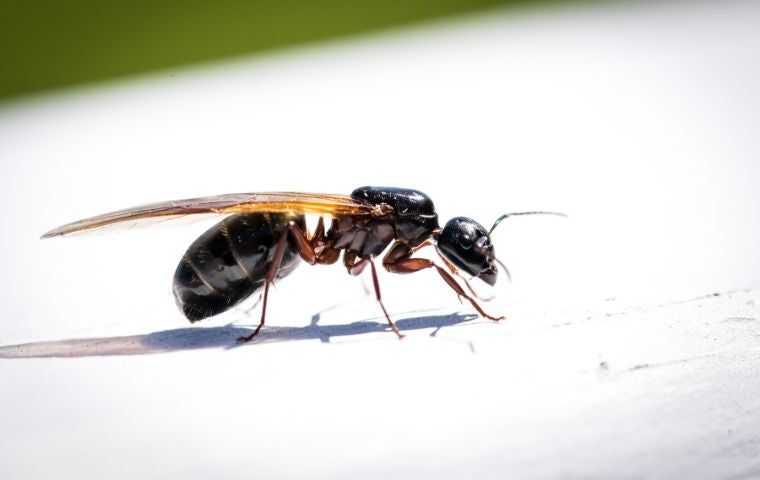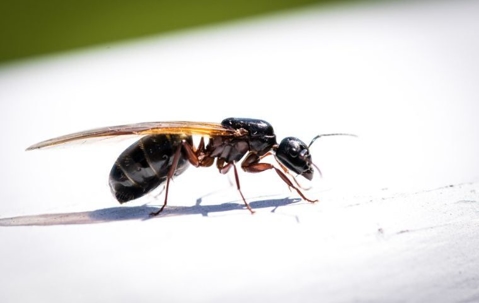Flying Ants
September 09, 2023 - Ants

Flying ants are a significant stage in the life cycle of certain ant species, particularly those that reproduce through a process called swarming. These ants typically undergo metamorphosis, transitioning from egg to larva to pupa before emerging as winged adults. The development of wings marks a crucial phase in the ant's life, signaling their readiness to embark on a nuptial flight.
During this nuptial flight, male and female ants from the same colony take to the air to mate. It's important to note that not all ant species have flying individuals; it's a characteristic mainly associated with reproductive ants. The wings of these ants are long and membranous, distinguishing them from the non-reproductive worker ants, which have shorter wings or none at all.
Flying ants are highly synchronized, with multiple colonies participating in these mating flights simultaneously. Once the male and female ants mate mid-air, the males perish, and the fertilized females land to establish new colonies. These newly fertilized females shed their wings as they begin their journey of excavation and nest-building.
The phenomenon of flying ants, often referred to as an "ant swarm," is usually seen during warm, humid weather, typically in late spring or early summer. It is a critical mechanism for the dispersal and reproduction of ant populations. While the sight of swarming flying ants can be disconcerting to some, it is a fascinating aspect of ant biology and their complex social structure.
When Do Ants Swarm?
Ant swarming, which involves the emergence of winged, reproductive ants for mating, occurs under specific environmental and seasonal conditions. These swarming events are typically timed to optimize the chances of successful reproduction. Here's a detailed explanation of when ants swarm:
Ant swarming predominantly takes place during warm, humid weather conditions. This is typically in late spring or early summer when temperatures rise and provide the ideal conditions for the flight. Warmth is crucial as it aids in the winged ants' ability to take to the air and fly.
The specific timing of ant swarming can vary depending on the ant species and the geographical location. However, it often coincides with periods of increased food availability, ensuring that the newly established colonies have access to ample resources to support their initial growth.
Swarming is also influenced by daylight. Most ant species engage in swarming flights during the daytime, as visibility is better, and it allows for easier mating in flight. Moreover, daylight hours provide the warmth required for the winged ants to become airborne.
Rainfall can delay or disrupt ant swarming. Heavy rains or adverse weather conditions may cause the ants to postpone their flights, as flying in wet conditions can be challenging and reduce their chances of successful mating.
Winged Ants
Ant colonies consist of several castes or types of individuals, each with specific roles and responsibilities. Winged ants, also known as alates, belong to two primary castes within ant colonies: the queens and the males.
Queens: Queens are the reproductive females in an ant colony, and they are typically the largest ants within the colony. Winged queens are those that have developed wings and are ready to embark on their nuptial flight. The primary purpose of winged queen ants is to mate with winged males from other colonies during their swarming flights. After mating, a queen sheds her wings and establishes a new colony, where she becomes the egg-laying, founding queen.
Males: Male ants, often referred to as drones, are responsible for mating with winged queens from other colonies during the nuptial flight. They have wings that are often longer and more delicate than those of the queens. Once mating occurs, males typically die, as they do not have a role in colony maintenance or worker activities.
Not all ant castes have wings. Worker ants, which make up the majority of the colony, are sterile females and do not possess wings. They perform various tasks such as foraging, caring for the brood, and maintaining the nest. Worker ants are crucial for the survival and daily operations of the colony.
Observing swarming ants can be a natural and intriguing phenomenon, but it may also raise concerns, especially if they are invading your living spaces. If you encounter swarming ants, here are steps you can take:
Identification: First, determine the type of ants you are dealing with. Some ants are harmless and only engage in swarming for mating purposes, while others can be household pests. Identifying the species will help you understand their behavior and potential risks.
Observation: Observe the ants to see if they are coming from a specific location or if they are just passing through. This can help you assess the extent of the swarm and whether it's a temporary event.
Avoid Disturbance: While it may be tempting to eliminate the swarm immediately, avoid disturbing the ants if they are not causing harm. Swarming is a crucial part of their reproductive cycle, and they will disperse on their own after mating.
Seal Entry Points: If swarming ants are entering your home or building, identify and seal off entry points. This can help prevent more ants from entering your space.
Clean Up: If the ants are indoors and becoming a nuisance, gently sweep or vacuum them up and dispose of them outdoors. Avoid using insecticides indoors unless absolutely necessary, as it can be harmful to humans and pets.
Consult a Professional: If the ant swarm is persistent or if you suspect an infestation, it's best to consult a pest control professional. They can assess the situation and provide appropriate treatment options to manage the ant population.
Preventive Measures: To prevent future ant infestations, maintain good hygiene practices, such as keeping food stored in airtight containers, cleaning up crumbs and spills promptly, and sealing any cracks or gaps where ants can enter your home.
Remember that swarming ants are generally a temporary event, and they will disperse once the mating process is complete. If you are unsure about how to handle the situation, seeking advice from a pest control expert is a prudent step to ensure effective and safe ant management.
Customer Review
Bret came to our home to treat our pest issues same day and was thorough and knowledgeable! Pricing was lower than 4 other companies I'd contacted. Highly recommend!


